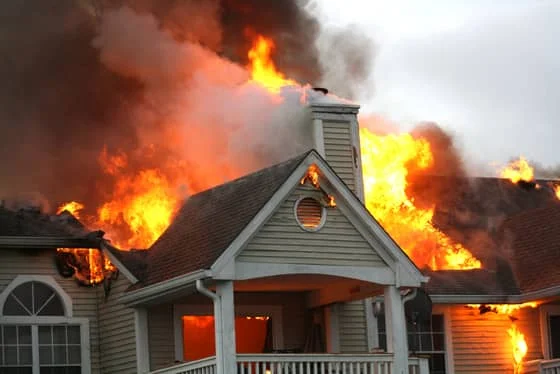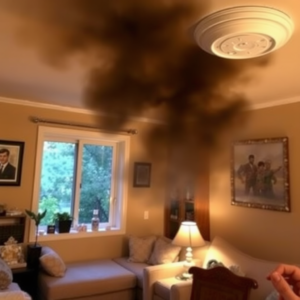Smoke alarms are important elements in every house functioning as a silent guard against the prevalence of fires. For homeowners, knowing where smoke detectors are required in a house can mean the difference between life and death.
Every year, these simple devices manage to save countless number of lives. Simply put, the smoke alarm systems are designed to warn people allowing them to evacuate and seek assistance promptly. According to the National Fire Protection Association (NFPA), it has been found that the risk of death in a residential fire incident is decreased by more than 50% with the presence of functional smoke detectors. There is no doubt that smoke detectors are crucial not only in terms of safeguarding possessions but more significantly, in ensuring the safety of people within the premises.
Most people don’t realize how quickly a fire can spread. In just two minutes, a fire can become dangerous and life-threatening. Within five minutes, an entire house could be engulfed in flames. Detecting a fire as soon as possible is essential, thanks to smoke detectors which are aimed at giving the alarm even before the smoke is smelt within the house.
Every house must be provided with smoke alarms but understanding how to optimally place them throughout or where are smoke detectors required in a house will increase their efficiency.
Required Locations for Smoke Detectors in a Home
The layout and size of your residence will determine where are smoke detectors required in a house, but there are universal guidelines that apply to most homes.
-
Bedrooms
All bedrooms must be equipped with a smoke detector. A majority of fires break out at night when people are sleeping, hence, It’s essential to have at least one smoke detector within waking distance of the room’s occupants. For optimum functionality, it is recommended that they be positioned on the ceiling or on a wall just below the ceiling close to where the occupants sleep.
-
Living Room
In living areas such as the living room, smoke detectors should be installed to cover communal spaces effectively. These spaces usually have electronics and other combustible materials that may cause fire. Therefore, It’s a good idea to install a detector at ceiling level in that central area so that any fires starting in or around these spaces can be easily detected.
-
Kitchen
Kitchens can be tricky due to the potential for false alarms from cooking. However, they are also a significant source of house fires. It is advisable to set up a detector in the vicinity, however not directly inside the kitchen region, preferably 10 ft. away from the cooking appliances in order to minimize unnecessary false alarms while still affording the required protection.
-
Hallways
Hallways, especially those leading to bedrooms, should have smoke detectors to serve as a protective barrier for sleeping areas. In the event that your residence incorporates an extended corridor, it might be prudent to install detectors at both termini in order to facilitate effective smoke detection irrespective of the source of the smoke.
-
Basement
Smoke detectors are frequently neglected during installation in basements. However, they are very important especially if there are laundry appliances o heating systems in a basement. Place the detector on the ceiling near the stairs leading up from the basement, as this is the most likely route for smoke to travel.
-
Attic
Smoke detectors are also required if the attic has been converted into a bedroom, or there are electrical components. While attics are not common fire hazards, installing a smoke detector in this area can provide early warning in case of a fire outbreak. This precaution enhances fire safety by ensuring prompt detection and response.
Legal Requirements and Building Codes
Compliance with local and national regulations regarding smoke detectors is crucial. Regulations can vary significantly depending on your location, so understanding these requirements is key to ensuring your home is up to code.
-
Local and National Regulations
The NFPA provides guidelines that many local building codes adopt or adapt .In general, they recommend that detectors have to placed inside every bedroom, installed just outside each sleeping area, and also on every level of the house including the basement. Some states may require additional detectors or have specific placement laws, so always check your local fire department’s regulations or consult a building inspector.
-
How to Determine Compliance in Your Area
To ensure compliance, contact your local fire marshal or building department. They can furnish recommendations for your region and suggestions on how to install them properly. Following building codes keeps you safe, and they can also affect your home insurance rates and eligibility.
Best Practices for Smoke Detector Placement
Beyond legal requirements, following best practices can enhance the safety provided by smoke detectors.
-
Guidelines for Optimal Coverage
For optimal coverage, place smoke detectors on ceilings, as smoke rises. If a ceiling placement is impractical, install detectors high on a wall. Do not install detectors near any openings, including windows or doors. They could be exposed to air flow as it might disrupt the proper functioning of the sensor. Smoke detectors that are linked are more secure than the other types because if one of them detects smoke, all sound an alarm at the same time.
-
Common Mistakes to Avoid
Avoid placing detectors in corners or recessed areas where smoke may not reach quickly. Additionally, refrain from covering or in any other way blocking any smoke detectors as it may affect its proper functioning. Finally, avoid placing any alarm units near bathrooms or wash areas, as water can cause false alarms.
Maintenance and Testing
To ensure smoke detectors function properly when needed, it’s crucial to regularly maintain and test them. It’s important to install smoke alarms in every room, including bedrooms, on every floor of the house, including the basement, and outside each sleeping area. Regularly clean smoke detectors to prevent dust buildup, which can impair their performance. Replace the batteries annually, unless they are built-in batteries designed to last 10 years. Test your smoke detectors monthly by pressing the test button to ensure they are functional. Make sure the alarm is loud enough to alert everyone in the house. In case a detector does not sound. In order to ensure sound performance, either change the batteries or the detector itself.
Conclusion
It is very important to know the places in the house where smoke detectors should be installed for safety purposes. Ensure smoke detectors are installed in all sleeping quarters and below ground levels to enhance fire safety. Proper setup and regular maintenance of these essential devices can significantly reduce the risk of fire-related dangers.
Consider reviewing your current smoke detector placements and making any needed adjustments. Encourage friends and family to do the same by sharing this guide with them. For further resources and expert advice on enhancing home safety, keep following our blog. Stay safe and informed, and take proactive steps today to protect your home and loved ones.



